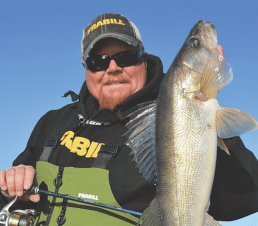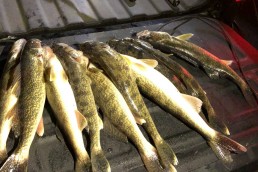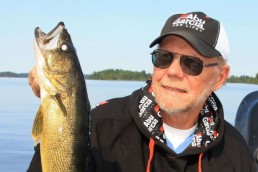Smorgasbord of Options: Tips for Early-summer Walleyes
SHARE THIS POST
Summer means something completely different in northern Minnesota than it does in most parts of the South, at least when it comes to hot weather. Temperatures in the far North very seldom exceed 100, with only a handful of days in the 90s occurring in an average summer. These temperatures happen in the South frequently in summer. These air temperatures translate directly into the water temperatures, with lakes closely reflecting the average between the daily highs and lows. Water temperatures in most northern lakes rarely exceed 80 degrees, while surface water temperatures in the South are routinely in the 80s and occasionally in the 90s in summer. When surface water temperatures in northern lakes exceed 80 degrees it can be big news, especially with many of the coldwater species in these lakes that are vulnerable to a “summer kill” when water temperatures get too warm.
Coldwater species in northern lakes include suckers, whitefish, tullibees and eelpout, with trout in a few lakes, known as the “ultimate coldwater species.”
All species have increased mortality rates during the summer. And their metabolism rates are at their highs for the year, with all fish needing to eat enough and take in calories to at least break even with the amount their bodies are burning off with said elevated metabolic levels.
Old, sick or unhealthy fish, or ones that get caught by anglers, have to recover fast enough to be able to resume normal feeding patterns before they burn all their fat reserves and become candidates for a summer kill. Anglers also need to release fish quickly during the heat of summer and be careful when unhooking fish to prevent delayed mortality in the fish they’re releasing.
Each 10-degree increase in water temperatures during spring and summer triggers changes in the fish population. Walleyes start out the open-water season with water temperatures in the 40s, which means they will be spawning in the lakes and rivers. Once surface water temperatures reach the 50s, walleyes resume normal feeding patterns and begin to disperse back into the lakes, primarily using shoreline structure, especially in larger lakes.
When surface water temperatures go into the 60s, sunfish, crappies, smallmouths, largemouths and muskies, all will spawn. Walleyes continue to disperse into the lakes as the insect hatches begin, heading for their summer haunts on mid-lake structures.
Typically, sometime in June or early July surface water temperatures will reach 70 degrees in northern lakes. The 70s are when summer fishing patterns develop, the algae blooms begin and thermoclines start to develop in the deeper lakes. Walleyes are at their maximum dispersal pattern in lakes during this 70-degree time frame. There will be walleyes using many different types of structure too, with these fish capable of suspending over deeper water, if, that is, where most of the baitfish is located. But once water temperatures reach into the upper 70s and low 80s, oxygen levels can become depleted in deeper water and almost all of the fish in the lakes will move shallow to take advantage of the higher levels.
Walleye anglers will use many different presentations during the 70-degree period, depending on where these fish are located and what type of live baits anglers have access to. The “go-to” search presentation for walleye anglers in much of the country are bottom bouncers and spinners so they can cover more water while searching for active fish.
Are you enjoying this post?
You can be among the first to get the latest info on where to go, what to use and how to use it!
Spinner rigs can be used and come in many different combinations with one- to three-hook rigs and an almost infinite number of combinations of beads, spinner colors and sizes and styles, as well as colors of hooks. Anglers may use nightcrawlers, leeches, minnows and plastics on their spinner rigs depending on what types of live bait they have access to in their region. Depending on the depth of the walleyes, spinner rigs can be used with bullet sinkers, bottom bouncers or can be used on planer boards.
Trolling crankbaits is another popular method. These can be trolled on planer boards or trolled with leadcore line, depending on the depth of the walleyes.
Tournament anglers are on the cutting edge of fishing and bring new presentations and techniques with them wherever they travel. One example of this would be when a few pros figured out the big walleyes on a South Dakota reservoir were using areas with deep standing timber. Instead of using crankbaits that would constantly get snagged or fishing vertically with jigging lures or bobber rigs, some figured out if they trolled bass spinnerbaits through the trees the walleyes were willing to bite them as they deflected off of the timber.
Live-bait rigging is a common presentation used in northern Minnesota, but it is not as popular a presentation in other parts of the country because anglers don’t have access to leeches or larger minnows. Many may be surprised to learn that walleye pros from other parts of the country that use trolling lures for walleyes actually often dread coming to lakes where live-bait rigs are needed for the species. These rigs are a finesse presentation because they require more practice to fish at a high level. Anglers have to feel the bites on a live-bait rig and feed line to the fish without the fish feeling them.
I like to use a 7- to 7 1/2-foot St. Croix Legend Elite Rod for live-bait rigging. I like a sensitive rod tip to feeI the light bites and a longer rod with some backbone to be able to take up slack line when I set the hook. I also like bullet sinkers when fishing live-bait rigs on weed edges and use an inflated nightcrawler or leech on a plain hook or a Gum-Ball Floating Jig head when fishing in weeds.
When fishing live-bait rigs in deeper water, I use a sliding bottom-bouncer sinker so I can feel the bites without the sinker catching on the bottom. I use either leeches or larger minnows when fishing walleyes on live-bait rigs in deeper water. I like to use braided line on my reels (8- or 10-pound-test line), but I always use a fluorocarbon leader (4- to 8-pound-test line) in lengths from 4 to 10 feet or longer, depending on the situation.
The biggest clue to walleye location during the summer is the location of the baitfish. Find the food and you will usually find walleyes taking advantage of the opportunity.
MWO
SHARE THIS POST
Did you enjoy this post?
You can be among the first to get the latest info on where to go, what to use and how to use it!
Brian 'Bro' Brosdahl
Outdoor communicator Brian “Bro” Brosdahl lives in northern Minnesota. He is a walleye guide in the Cass Lake, Leech Lake and Lake Winnibigoshish areas. He is sponsored by Northland Fishing Tackle, Frabill/Plano, Aqua-Vu, Humminbird/Minn Kota, St. Croix Rods, Ranger Boats, and Evinrude. Guide inquiries: brosguideservice.com. Follow on social media.



